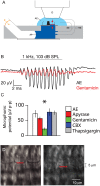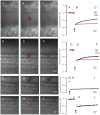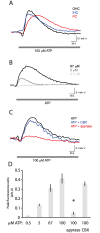Sound-Induced Intracellular Ca2+ Dynamics in the Adult Hearing Cochlea
- PMID: 27959894
- PMCID: PMC5154517
- DOI: 10.1371/journal.pone.0167850
Sound-Induced Intracellular Ca2+ Dynamics in the Adult Hearing Cochlea
Abstract
Ca2+ signaling has been implicated in the initial pathophysiologic mechanisms underlying the cochlea's response to acoustic overstimulation. Intracellular Ca2+ signaling (ICS) waves, which occur in glia and retinal cells in response to injury to activate cell regulatory pathways, have been proposed as an early event in cochlear injury. Disruption of ICS activity is thought to underlie Connexin 26-associated hearing loss, the most common genetic form of deafness, and downstream sequelae of ICS wave activity, such as MAP kinase pathway activation, have been implicated in noise-induced hearing loss. However, ICS waves have only been observed in neonatal cochlear cultures and are thought to be quiescent after the onset of hearing. In this study, we employ an acute explant model of an adult, hearing cochlea that retains many in vivo physiologic features to investigate Ca2+ changes in response to sound. We find that both slow monotonic changes in intracellular Ca2+ concentration as well as discrete ICS waves occur with acoustic overstimulation. The ICS waves share many intrinsic features with their better-described neonatal counterparts, including ATP and gap-junction dependence, and propagation velocity and distance. This identification of ICS wave activity in the adult, hearing cochlea thus confirms and characterizes an important early detection mechanism for cochlear trauma and provides a target for interventions for noise-induced and Connexin 26-associated hearing loss.
Conflict of interest statement
The authors have declared that no competing interests exist.
Figures






Similar articles
-
Noise induces Ca2+ signaling waves and Chop/S-Xbp1 expression in the hearing cochlea.JCI Insight. 2024 Dec 10;10(2):e181783. doi: 10.1172/jci.insight.181783. JCI Insight. 2024. PMID: 39661633 Free PMC article.
-
In Vitro Models of GJB2-Related Hearing Loss Recapitulate Ca2+ Transients via a Gap Junction Characteristic of Developing Cochlea.Stem Cell Reports. 2016 Dec 13;7(6):1023-1036. doi: 10.1016/j.stemcr.2016.10.005. Epub 2016 Nov 10. Stem Cell Reports. 2016. PMID: 27840044 Free PMC article.
-
Critical role of ATP-induced ATP release for Ca2+ signaling in nonsensory cell networks of the developing cochlea.Proc Natl Acad Sci U S A. 2016 Nov 15;113(46):E7194-E7201. doi: 10.1073/pnas.1616061113. Epub 2016 Nov 2. Proc Natl Acad Sci U S A. 2016. PMID: 27807138 Free PMC article.
-
ATP-dependent intercellular Ca2+ signaling in the developing cochlea: facts, fantasies and perspectives.Semin Cell Dev Biol. 2013 Jan;24(1):31-9. doi: 10.1016/j.semcdb.2012.09.004. Epub 2012 Sep 28. Semin Cell Dev Biol. 2013. PMID: 23022499 Review.
-
Nitric oxide--a versatile key player in cochlear function and hearing disorders.Nitric Oxide. 2012 Aug 15;27(2):106-16. doi: 10.1016/j.niox.2012.05.005. Epub 2012 Jun 1. Nitric Oxide. 2012. PMID: 22659013 Review.
Cited by
-
Osmotic stabilization prevents cochlear synaptopathy after blast trauma.Proc Natl Acad Sci U S A. 2018 May 22;115(21):E4853-E4860. doi: 10.1073/pnas.1720121115. Epub 2018 May 7. Proc Natl Acad Sci U S A. 2018. PMID: 29735658 Free PMC article.
-
Age-related changes in P2Y receptor signalling in mouse cochlear supporting cells.J Physiol. 2023 Oct;601(19):4375-4395. doi: 10.1113/JP284980. Epub 2023 Sep 16. J Physiol. 2023. PMID: 37715703 Free PMC article.
-
TMTC4 is a hair cell-specific human deafness gene.JCI Insight. 2023 Dec 22;8(24):e172665. doi: 10.1172/jci.insight.172665. JCI Insight. 2023. PMID: 37943620 Free PMC article.
-
Noise induces Ca2+ signaling waves and Chop/S-Xbp1 expression in the hearing cochlea.JCI Insight. 2024 Dec 10;10(2):e181783. doi: 10.1172/jci.insight.181783. JCI Insight. 2024. PMID: 39661633 Free PMC article.
-
NADPH Oxidase 3: Beyond the Inner Ear.Antioxidants (Basel). 2024 Feb 8;13(2):219. doi: 10.3390/antiox13020219. Antioxidants (Basel). 2024. PMID: 38397817 Free PMC article. Review.
References
-
- Munoz DJB, Kendrick IS, Rassam M, Thorne PR (2001). Vesicular storage of adenosine triphosphate in the guinea-pig cochlear lateral wall and concentrations of ATP in the endolymph during sound exposure and hypoxia. Acta Otolaryngol 121:10–15. - PubMed
-
- Gale JE, Piazza V, Ciubotaru CD, Mammano F (2004). A Mechanism for sensing noise damage in the inner ear. Curr Biology 14:526–529. - PubMed
MeSH terms
Substances
Grants and funding
LinkOut - more resources
Full Text Sources
Other Literature Sources
Molecular Biology Databases
Miscellaneous

